Table of Contents
Table of Contents
- What is SEO Competitor Analysis?
- Why is SEO Competitor Analysis Important for Agencies?
- When Should You Conduct An SEO Competitor Analysis?
- How To Identify Your Clients’ SEO Competitors
- How To Run an SEO Competitive Analysis: Step By Step
- Free SEO Competitor Analysis Checklist
- Competitor Analysis: The Secret to Elevating Your SEO Strategy
7,000+ agencies have ditched manual reports. You can too.
Free 14-Day TrialQUICK SUMMARY:
SEO competitor analysis is the process of evaluating your competitors' SEO strategies. By gaining a clear understanding of their strengths and weaknesses, you refine SEO strategies for clients (or your own SEO strategy), improve search rankings, and help clients gain a competitive advantage in their market. This article offers a step-by-step guide on how to do an SEO competitor analysis, complete with a free checklist to help you get started.
Many of your clients likely view their competition as something that needs to be defeated—yet in certain circles, such as sports, the competition is actually a great source of intel.
Athletes often spend hours studying their competitors' performances, trying to learn from their strengths and weaknesses. The same goes for SEO. It’s amazing how much you can improve your clients’ rankings through competitive analysis.
In this guide, we'll share a step-by-step approach to understanding your clients’ competition and give you the insights you need to improve their organic traffic and page rankings.
What is SEO Competitor Analysis?
SEO competitor analysis is a strategic process in digital marketing that examines the SEO strategies and tactics of your client’s main organic competitors. It involves analyzing the key factors influencing a competitor's online visibility and search engine rankings to uncover actionable insights.
This analysis helps identify what strategies are driving competitor success, where gaps or weaknesses exist, and how your client can capitalize on these opportunities to improve their own SEO performance.
An effective SEO competitor analysis evaluates essential factors, such as:
Relevant Keywords: Identifying the keywords competitors rank for, their search volume, and their positions in search results. If a competitor ranks well for a valuable keyword, your client should aim to compete for those terms.
Existing Content: Analyzing the type, quality, and frequency of competitor content, including blogs, videos, and articles. A content gap analysis reveals opportunities for your client to create high-performing content.
Backlinks: Evaluating the quantity and quality of backlinks pointing to competitor websites. Competitor backlink analysis helps identify link-building opportunities for your client.
Website Structure and User Experience: Assessing competitors' site architecture, navigation, mobile optimization, and page speed. Addressing weaknesses, like slow load times, can give your client a competitive edge.
Social Signals: Examining how competitors use social media to boost SEO, increase visibility, and engage their audience effectively.
SEO Performance Metrics: Tracking key SEO metrics such as keyword rankings, organic traffic, and click-through rates using dedicated SEO tools. These insights highlight the strengths and weaknesses of competitor strategies.
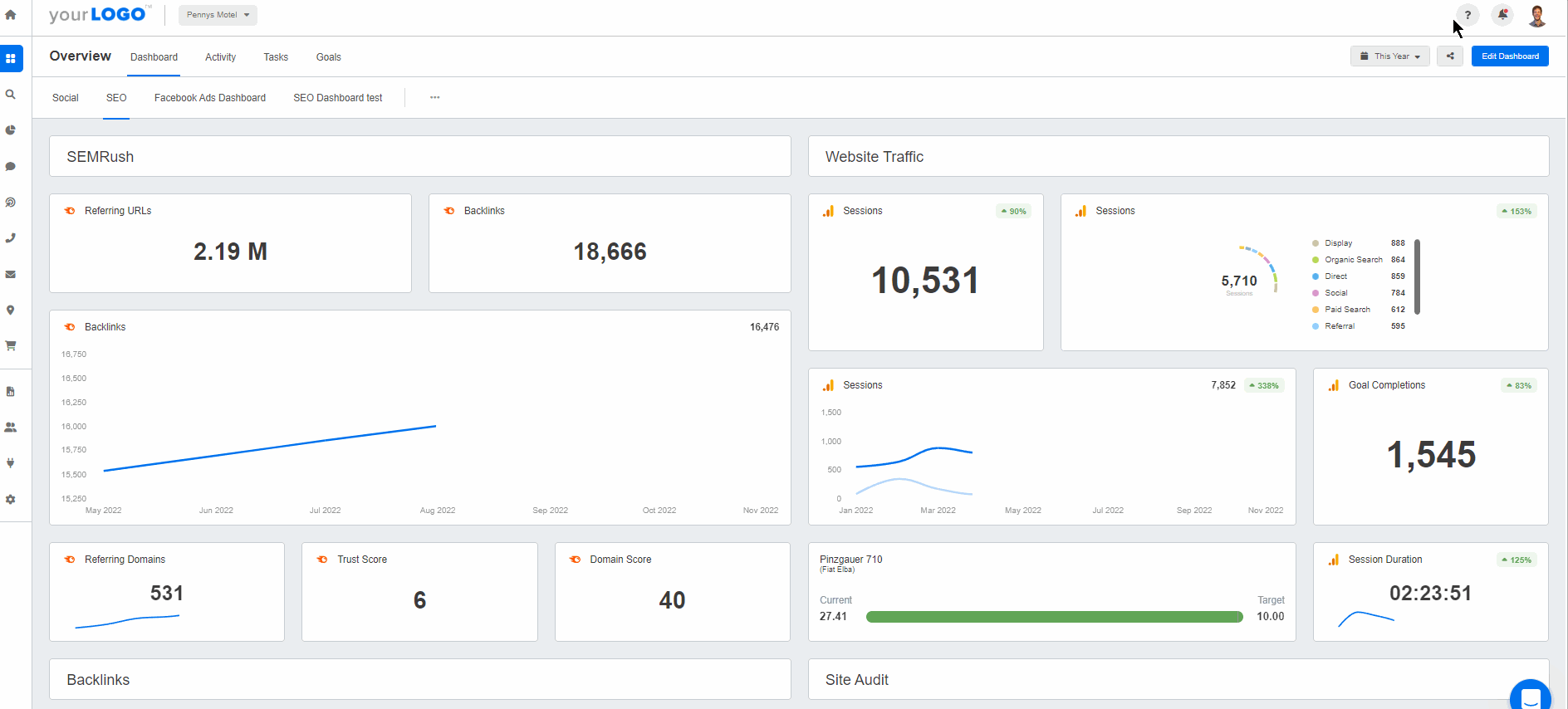
Monitor advanced SEO metrics like trust score and domain scores in a custom dashboard that you and your clients access in real-time. Start a 14 day free trial of AgencyAnalytics.
The goal of SEO competitor analysis isn't to simply mimic what competitors are doing. Rather, it's about gaining insights into industry trends, identifying content gaps or gaps in your clients' strategies, and finding opportunities to innovate and outperform organic competitors.
Why is SEO Competitor Analysis Important for Agencies?
SEO competitor analysis isn’t just about observing what others are doing—it’s about uncovering actionable insights that guide smarter strategies and deliver measurable results.
Agencies looking to outrank their clients' competitors need a reliable roadmap, and competitor SEO analysis provides just that. When done correctly, it eliminates trial and error, prevents wasted resources, and delivers data-backed insights for building a winning strategy.
Let’s explore the value of SEO competitor analysis for marketing agencies further:
Eliminates Trial and Error: Instead of relying on guesswork or untested tactics, competitor analysis provides a clear understanding of what’s already working in the market. This reduces the risk of implementing ineffective SEO techniques and ensures every move is deliberate and impactful.
Prevents Wasted Resources (Time & Budget): Poorly planned strategies can drain time and money. With competitor analysis, agencies focus on high-impact activities that are more likely to yield results.
Uncovers Niche and Local Insights: For location-specific businesses, analyzing competitors’ websites reveals local search trends and directory opportunities (e.g., Google Business Profiles, Yelp). Agencies then optimize clients’ listings on relevant local platforms to drive better visibility in local search results.
For example, if your client runs a dental practice, getting them to outrank competitors will require specific dental SEO strategies to give them a boost in their local markets. Try a local digital marketing approach that includes optimizing their website for particular local directories their audience is using, such as Google Business Profiles, Yelp, and so on.
Guides Informed Decision Making: SEO competitor analysis generates concrete, data-backed insights into keyword performance, competitors’ backlinks, content effectiveness, and traffic patterns. This reliable data helps agencies prioritize tasks, create superior content, and make informed recommendations backed by evidence rather than assumptions.
Builds Competitive Advantage: Conducting a thorough competitive analysis helps identify where you can leverage your client’s strengths against their competitor’s weaknesses and shore up the areas where your client may be vulnerable. SEO competitor research isn’t a one-time task either—it’s an ongoing process that helps agencies stay agile and proactive. Long-term monitoring ensures clients don’t just rank well temporarily but maintain dominance over time.
SEO competitive analysis equips agencies with the insights and clarity they need to build smarter strategies, maximize resources, and deliver measurable results. It’s not just about outperforming competitors—it’s about setting a foundation for long-term success.
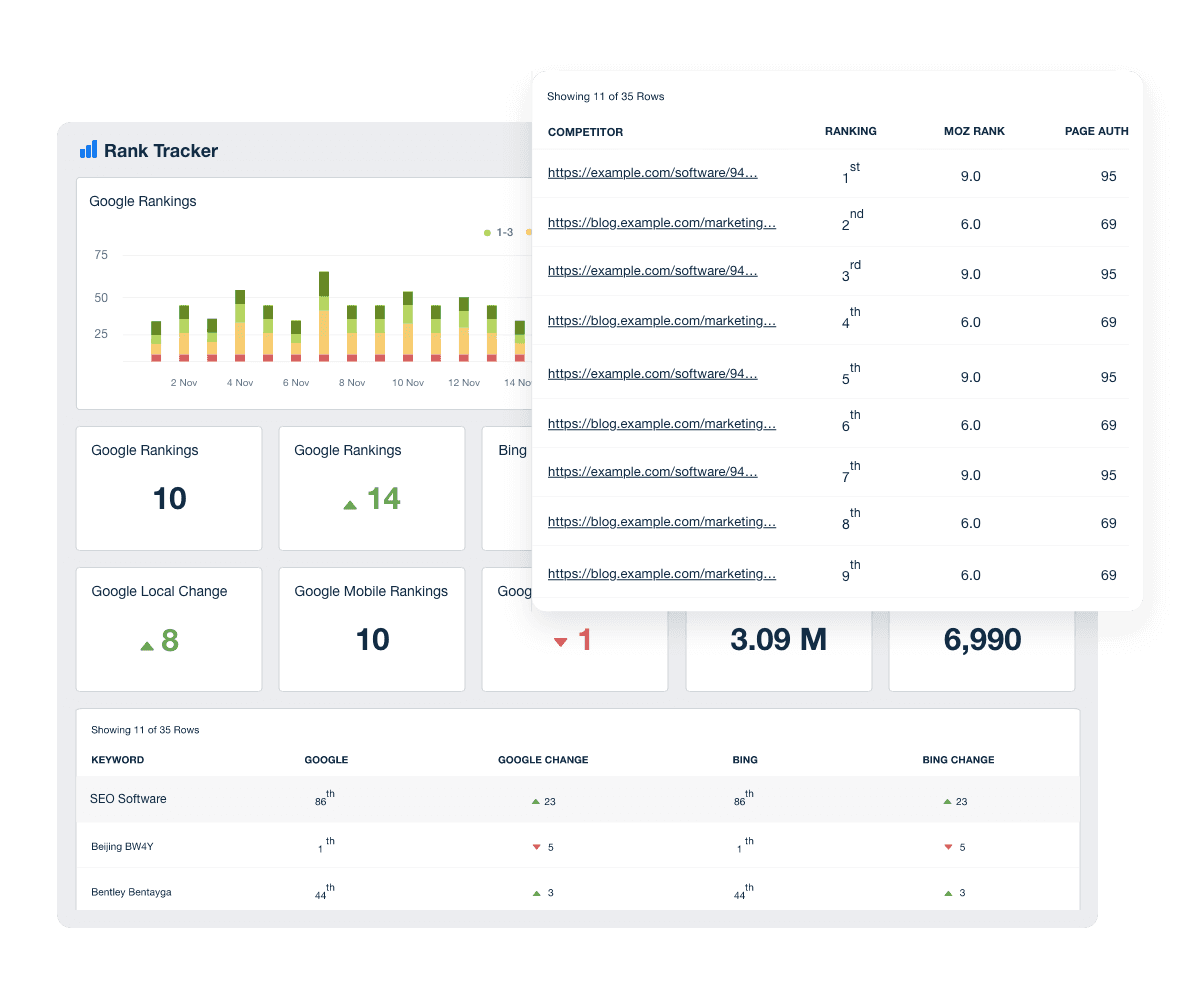
When Should You Conduct An SEO Competitor Analysis?
SEO competitor analysis is an ongoing process that evolves alongside search engines, competitors, and user behavior. Search algorithms frequently update, websites are restructured, new content emerges, and search engines continuously refine how they display results, including featured snippets, meta descriptions, and knowledge panels.
Consider this: If a competitor optimizes their website with enhanced schema markup and integrates local keywords more effectively, search engines like Google might reward them with higher visibility in search results or even a coveted featured snippet. Meanwhile, your client’s website could slip down to the second, third, or even fifth page—effectively vanishing from a user’s view.
These shifts may go unnoticed without consistent monitoring, leaving opportunities untapped and your client's SEO performance lagging behind.
Best Times To Conduct SEO Competitive Analysis
While competitive analysis for SEO should be a regular part of your agency's workflow, certain milestones call for an evaluation:
After a Major Search Algorithm Update: Google regularly rolls out core algorithm updates that may significantly impact rankings. Analyzing competitor sites after these updates helps you understand how competitors have adapted and what changes you might need to make.
When You Notice Ranking Drops or Stagnation: If your client’s website stops climbing the rankings or starts losing visibility, it’s time for a fresh analysis. Competitors might have made strategic improvements that need to be countered.
During a Website Redesign or Migration: A website redesign is an excellent time to assess competitors’ technical SEO, content structure, and user experience. This ensures your client’s new site outperforms others from launch.
Before Launching a Major SEO Campaign: Whether it’s a content initiative, backlink strategy, or local SEO push, competitor analysis ensures your plans are built on solid insights rather than assumptions.
When Entering a New Market or Niche: If your client is expanding into a new geographic area or targeting a different audience segment, an SEO competitor analysis reveals market-specific opportunities and challenges.
Regular Check-Ins (Quarterly or Bi-Annually): Even if no major changes occur, a routine analysis every few months keeps your strategy sharp and proactive.
Stay Agile By Considering The Impact of AI Search Engines
While Google remains dominant, the emergence of AI-powered search engines, such as Microsoft Bing (integrated with ChatGPT), and platforms like Perplexity.ai are changing how users search for information, how results are displayed, and how websites gain visibility. These AI search engines are becoming serious contenders, offering conversational search experiences, personalized results, and AI-generated summaries.
This shift means agencies and businesses can no longer afford to focus solely on traditional search engines—they must adapt to this new ecosystem. To stay ahead of the curve, agencies should extend SEO competitor analysis beyond Google to include audits on these emerging platforms. Understanding the types of content these platforms prioritize—such as clear, well-structured content that directly answers user questions—will only allow agencies to create strategies that align with AI-driven search behavior.
Regularly auditing competitors across multiple platforms and adapting to changing algorithms is key to helping clients stay visible and relevant.
How To Identify Your Clients’ SEO Competitors
Understanding who your clients are competing with in search results is the foundation of a winning SEO strategy. It’s not always their direct business rivals, either—sometimes, unexpected players dominate key search terms.
Before conducting a competitive analysis, let’s review a few things to keep in mind and how to go about identifying your client’s main competitors:
1. Distinguish Between Business Competitors and SEO Competitors
First, understand the difference between business competitors and SEO competitors. While direct business competitors offer similar products or services, search competitors (or online competitors) may operate in entirely different industries but still compete for the same keywords and online visibility.
For example, a swimwear company, a sunscreen brand, and a sunglass retailer may not directly compete in terms of products, but they all compete for search visibility on keywords like “best beach essentials” or “how to pack for a day at the beach.”
This overlap happens because SEO competition is driven by user search intent rather than product offerings. When users search for information, they don’t differentiate between brands—they simply click on the most relevant result.
Making the distinction is particularly important in content-rich niches where indirect competitors often dominate search traffic.
2. Use Search Engine Results for A First Glance
Search engines are one of the most straightforward tools for uncovering SEO competitors. By analyzing search engine results, you quickly identify which websites dominate the organic rankings. This approach helps agencies understand who their client is up against and what type of content is performing well.
Conduct simple searches using primary and secondary keywords relevant to your client’s business. Look at the top-ranking organic results, as well as any SERP features like:
Featured snippets
Meta descriptions
People Also Ask sections
Local pack results
Image and video results
These areas highlight the strongest competitors for specific queries. Take note of which websites consistently appear at the top across different keywords and SERP formats—they are the primary SEO competitors.
3. Ask Your Clients Directly
Your clients are one of the best sources for identifying key competitors. They have first-hand knowledge of their industry, market trends, and who they see as rivals—both online and offline.
Engage with your clients to understand their perspectives on direct and indirect competitors. Ask targeted questions like:
“Who do you consider your biggest competitors online?”
“Are there specific brands or websites you often compare yourself to?”
“What strategies do you notice competitors using effectively in your space?”
“How often do you check on your competitors' online presence?”
These questions help uncover not only obvious competitors, but also lesser-known ones that might not immediately surface in keyword research. Pay attention to how clients describe their competitors. They might mention content styles, backlink strategies, or even specific campaigns. Use these details to guide your SEO analysis and highlight areas worth exploring.
4. Leverage SEO Tools
After gathering your clients' perspectives, cross-reference their answers with an SEO competitor analysis tool to validate competitor rankings. While client insights provide valuable context, dedicated competitor analysis tools for SEO offer the hard data needed to validate assumptions, uncover hidden opportunities, and refine your strategy.
Tools like SEMrush, Ahrefs, and Moz offer comprehensive insights into competitor strategies by analyzing:
Keyword Overlaps: Identifying the keywords your competitors are ranking for and comparing them with your client’s target keywords. Use this data to look for keyword gaps where competitors are performing well but your client is not.
Backlink Profiles: Analyzing competitors’ backlinks to understand which high-authority websites are linking to competitor content. This helps identify backlink opportunities to target for your client.
Content Performance: Pinpointing which competitor pages are driving the most traffic. Use this data to assess whether their content is answering search intent better or if their content is more comprehensive.
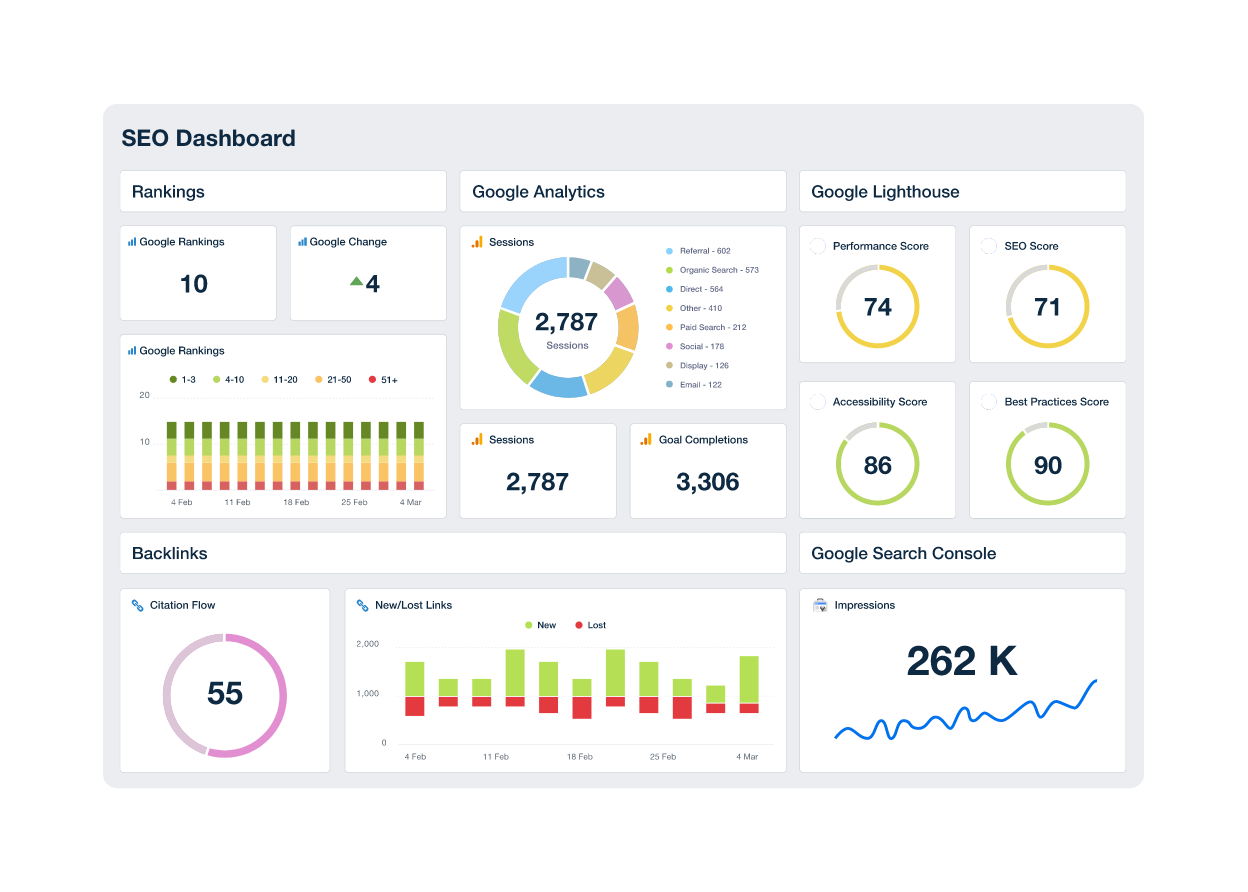
Juggling multiple tools gets overwhelming, especially when dealing with large datasets. AgencyAnalytics seamlessly integrates with platforms like SEMrush, Ahrefs, and Moz, pulling all your competitor analysis data into one customizable dashboard. Try it free for 14 days.
5. Keep an Eye on Social Media
Social media is a treasure trove for SEO competitor analysis. Platforms like Instagram, Facebook, LinkedIn, X (Twitter), and TikTok offer a window into how competitors are engaging with their audiences, promoting content, and driving traffic back to their websites.
Start by assessing which competitors are most active and influential across key social media platforms. Competitors with strong social engagement often have equally effective SEO strategies, as social shares and audience interactions may indirectly impact search rankings.
Search for relevant hashtags and keywords on platforms like Instagram or LinkedIn to see which brands dominate conversations.
Pay attention to brands with high engagement rates—likes, comments, shares, and mentions.
Look at which posts are driving traffic back to their websites and analyze the content formats (e.g., videos, infographics, blog links).
To save time, use tools like Sprout Social, Hootsuite, or BuzzSumo to track competitors' social engagement metrics and identify top-performing content pieces.
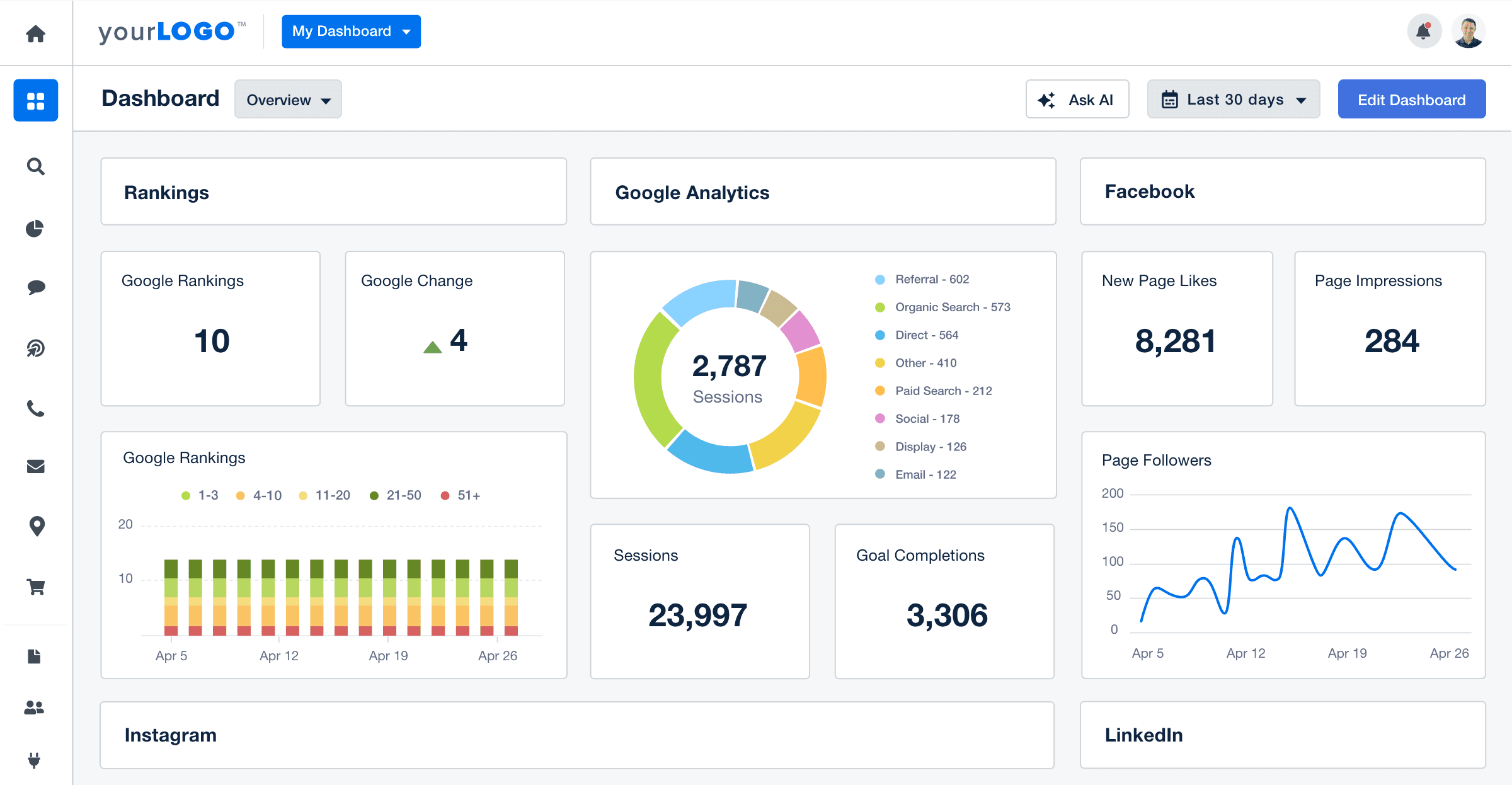
Managing social media data alongside SEO insights can be time-consuming. AgencyAnalytics simplifies this process by integrating social media analytics with SEO data, giving you a complete view of your competitors’ digital presence. Start your 14-day free trial of AgencyAnalytics today!
6. Monitor Industry Forums and Discussions
Online communities and industry forums are often overlooked sources of valuable competitor insights. Platforms like Reddit, Quora, and niche-specific forums provide real-time discussions where industry players share advice, ask questions, and showcase expertise. Actively participating—or even just observing—these spaces may reveal rising competitors, new trends, and untapped content opportunities.
Join and monitor relevant industry forums, LinkedIn groups, and discussion boards where your clients' audiences are active. Pay attention to:
Who is answering questions and gaining traction in discussions?
Which brands are being recommended or repeatedly mentioned?
What topics are generating the most engagement?
These spaces often highlight smaller or emerging competitors that may not yet dominate search rankings but are gaining credibility and audience trust.
AGENCY TIP: Set up Google Alerts for key industry terms and forum discussions to stay informed about trending conversations.
7. Pay Attention To Paid Advertisement
Paid search ads are a clear indicator of which competitors are actively investing in search engine marketing (SEM) to capture audience attention. These ads often reveal competitors who may not rank organically but are still vying for visibility on high-value keywords.
Monitor platforms like Google Ads and Bing Ads to see which brands consistently appear in sponsored results for your client’s target keywords. Pay attention to:
Top Bidders: Who appears in the first ad slots for competitive keywords?
Ad Messaging: What unique selling points are competitors highlighting?
Landing Pages: Where do these ads direct users, and how are those pages optimized?
Regularly Update the Competitor List
Your client’s competitor list is never set in stone. New players enter the market, established competitors refine their tactics, and search engine algorithms continually evolve, reshaping rankings and visibility overnight. Staying competitive means keeping your finger on the pulse of these changes and regularly revisiting your competitor list.
Make it a habit to conduct routine competitor audits using tools like SEMrush, Ahrefs, and AgencyAnalytics to gather up-to-date insights on rankings, backlinks, and keyword performance. Beyond SEO tools, monitor social media trends, paid search campaigns, and industry forums to spot emerging competitors and shift strategies early.
Regular updates ensure your SEO approach remains proactive, data-driven, and aligned with the realities of the market.
How To Run an SEO Competitive Analysis: Step By Step
Running an SEO competitive analysis is both an art and a science. That said, it's virtually impossible to understand exactly how Google and newer platforms will rank a particular page. While studying a competitor's SEO strategy is certainly valuable, keep in mind that rankings fluctuate constantly, and this should never be the only thing you learn from the competition.
Here are a few steps to follow to conduct your competitive analysis effectively:
Step 1: Finalize A List of SEO Competitors
After identifying potential competitors through client discussions, search engine research, SEO tools, and social media monitoring, it’s time to narrow down your list to the most relevant contenders.
A long list of competitors will make analysis overwhelming and dilute focus, so the goal is to create a refined list of 5–10 key competitors that truly matter.
Start by evaluating each competitor based on:
Keyword Overlap: How many target keywords does your client share with each competitor? More overlap often means higher competition.
Industry Relevance: Are they genuinely competing in your client’s niche, or are they informational sites like Wikipedia or large retailers dominating high-volume keywords?
While sites like Wikipedia, major news outlets, or top-tier retailers might rank for similar keywords, they often aren’t direct competitors. Competing with them is often resource-intensive with limited payoff. Instead, focus on competitors with similar goals, audiences, and keyword priorities.
Next, refine and finalize your list:
Consolidate Data: Merge competitor lists gathered from various sources (clients, tools, and manual research).
Eliminate Irrelevant Domains: Remove competitors that are too broad, out of scope, or impossible to compare effectively.
Prioritize Direct Competitors: Focus on those most aligned with your client’s audience, content focus, and keyword targets.
By the end of this process, you should have a streamlined list of 5–10 well-defined SEO competitors ready for deeper analysis.
A refined competitor list ensures your team can dive deeper into actionable insights without getting lost in irrelevant data, ultimately setting the stage for a focused, results-driven SEO strategy.
Step 2: Run a Competitive Keyword Ranking and SEO Audit
To understand which competitors are dominating the SEO landscape, you’ll need to run a comprehensive SEO audit and keyword ranking analysis for each of your client’s key competitors. This step sets a performance benchmark, revealing strengths, weaknesses, and opportunities in their SEO strategies.
Run an SEO site checkup and keyword ranking report on each of the competing websites to set a baseline.
Key SEO KPIs To Compare:
Website Authority and Trust Score: High authority scores indicate credibility with search engines. Competing with established domains (Authority Score above 50) requires a focused strategy on content quality and backlink acquisition.
Number of Indexed Pages: Websites with thousands of indexed pages have an inherent advantage in search visibility. If your client’s site is smaller, a content growth plan will be essential.
Backlinks and Linking Domains: Backlinks remain a cornerstone of domain authority and rankings. Analyze both the quality and quantity of competitor backlinks to identify link-building opportunities.
Keywords in the Top 10: Track competitors' high-ranking keywords. These insights reveal content opportunities and keyword gaps your client can target to improve visibility.
The AgencyAnalytics rank tracker tool and its other SEO reporting tools help you determine which keywords (and their competitor's keywords) are ranking well and which are not. Check out our keyword ranking report template in action.
Read More: Pros & Cons of the Best Keyword Rank Tracker Tools
How To Conduct An SEO Site Audit Effectively
Here are a few tips for conducting a comprehensive website audit.
1. Use Advanced SEO Tools
Leverage tools like SEMrush, Ahrefs, or Moz to automate audits and create detailed, side-by-side comparisons of your client’s website and its competitors. These tools help identify:
Keyword gaps where competitors are excelling.
Technical issues that could be holding your client’s website back.
Backlink profiles and linking strategies.
2. Complete a Competitor Domain Analysis
Using a competitor analysis tool is another way to analyze a competitor's SERP results and website authority.
This is an example of a competitor dashboard created with AgencyAnalytics. It provides several key metrics, such as:
Indexed Pages
Linking Domains
Backlinks
Keywords in the Top 10
These insights offer a clear roadmap for strategic improvements, helping your team prioritize actions that will yield the most impact.
3. Address Technical SEO Issues on Your Client’s Website
Don’t just focus on competitor data—ensure your client’s website is technically sound. Technical SEO issues include everything from broken links and indexability to H1 title tags and meta descriptions. Making any necessary improvements results in their site getting more visibility.
Use an SEO audit tool to detect and address common issues like:
Next, sort and prioritize these issues by severity to maximize impact.
AGENCY TIP: If you notice your client’s ecommerce business isn’t gaining traction like it used to, it’s time to look into Shopify SEO strategies. Keeping track of their Shopify analytics in an ecommerce dashboard proves that your agency is taking the necessary steps to improve your client’s traffic and, ultimately, their bottom line.
Step 3: Conduct Keyword Gap Analysis To Identify New Opportunities
A keyword gap analysis is a critical step in uncovering untapped opportunities and identifying areas where your client could gain a competitive edge in search rankings. This process involves comparing your client’s current keyword performance with that of their top competitors to pinpoint gaps, quick wins, and high-value keywords that deserve attention.
Using tools like SEMrush, Ahrefs, or Moz, run a keyword gap analysis report to identify:
High-Potential Keywords: Keywords where your client ranks just outside the top positions (e.g., positions 11–15). These are low-hanging fruit where small optimizations could drive big results.
Competitor-Dominated Keywords: Keywords where competitors rank highly, but your client is absent or far behind in the results.
Untapped Keywords: Keywords your client isn’t targeting at all, despite strong search volumes and competitor activity.
AGENCY TIP: Prioritize keywords that have high search intent, strong commercial value, and manageable competition levels to deliver quicker wins.
Once you’ve identified the target keywords, dig deeper into why competitors are outperforming your client. Ask key questions:
Content Relevance: Do competitors have more in-depth, well-structured content around the keyword?
Backlink Profile: Are competitors benefiting from authoritative backlinks pointing to their target pages?
On-Page SEO: Are they optimizing meta titles, descriptions, headers, and internal linking better?
User Engagement: Is their content generating better engagement metrics like time on page, lower bounce rates, or social shares?
These insights will guide your strategy to either improve existing content or create new, highly targeted content to close the gap.
Step 4: Competitor Content Analysis and Idea Discovery
Analyze the competitor’s content on a page-by-page basis. This helps you understand why that particular page is ranking higher than your client. If your client has an ecommerce business, do they have ‘How-To’ content that supplements their product pages? Do they have product descriptions or reviews listed on their website? Make a list of any areas you could improve on your client’s website where their competitors are excelling or areas where competitors are lacking that your team can take advantage of.
Also, one of the best ways to get ideas for new articles is by looking at what your client’s competition is publishing. While you certainly don't want to copy their work, use it as a source of inspiration for your own content calendar.
Make a note of which posts have been liked and shared the most. Are they seeing success with videos, infographics, or blog posts? This could be an indication of other media formats to incorporate into your client’s content strategy.
Consider how they're promoting their content and if there are elements that you can incorporate into your client’s strategy:
Are they utilizing their social media platforms?
Email marketing?
Syndication and guest posting?
Analyzing your competition's promotional strategy is a great way to inform your strategy to promote your client’s content.
AGENCY TIP: Don’t forget about guest posting on other websites in your client’s industry. Often, this is best suited for other websites that are not direct competitors but that offer some complementary product or service. Guest posting is a great way to get your business in front of a new audience while also increasing your client’s domain authority with a backlink.
Evaluate the Competition's Top Pages Data
There are many different kinds of "Top Pages" data, and each may be helpful in improving your client’s SEO analysis. For example, analyze top pages by links, social shares, organic traffic, total traffic, and so on. Look at which content has been the most successful and which hasn't performed as well.
Try to find any gaps in their strategy and then brainstorm ways to fill them. Perhaps they had some successful posts a few years ago but haven't taken the time to update them—this is a great opportunity to capitalize on by giving the same ideas a fresh twist on your client’s blog.
The key is to analyze the competition’s top page data, and learn from their success and their shortcomings while still tailoring your client’s marketing strategy to their own unique audience.
Step 5: Run a Competitor Backlink Analysis
By examining the competitors’ backlinks profiles, you uncover valuable link-building opportunities, understand which domains hold the most authority in your client’s niche, and identify strategies that are driving competitor success.
Backlinks are essentially votes of confidence from other websites. Search engines view high-quality backlinks as signals of trust and authority. However, not all backlinks are created equal. A few authoritative, relevant backlinks are far more valuable than dozens of low-quality links.
When conducting a backlink audit, focus on these key elements:
Link Quality: Are competitors earning links from high-authority domains?
Link Quantity: How many referring domains are pointing to their content?
Anchor Text: What anchor text are competitors using for their backlinks?
Top-Linked Pages: Which competitor pages attract the most backlinks?
Pay attention to pages on competitor sites that are earning the most backlinks and evaluate what makes those pages link-worthy (e.g., original research, unique resources, compelling content).
Remember that backlink strategies aren’t static—competitors are constantly gaining and losing links. Set up regular backlink monitoring to track:
New backlinks earned by competitors
Lost backlinks that could present opportunities
Shifts in competitor domain authority
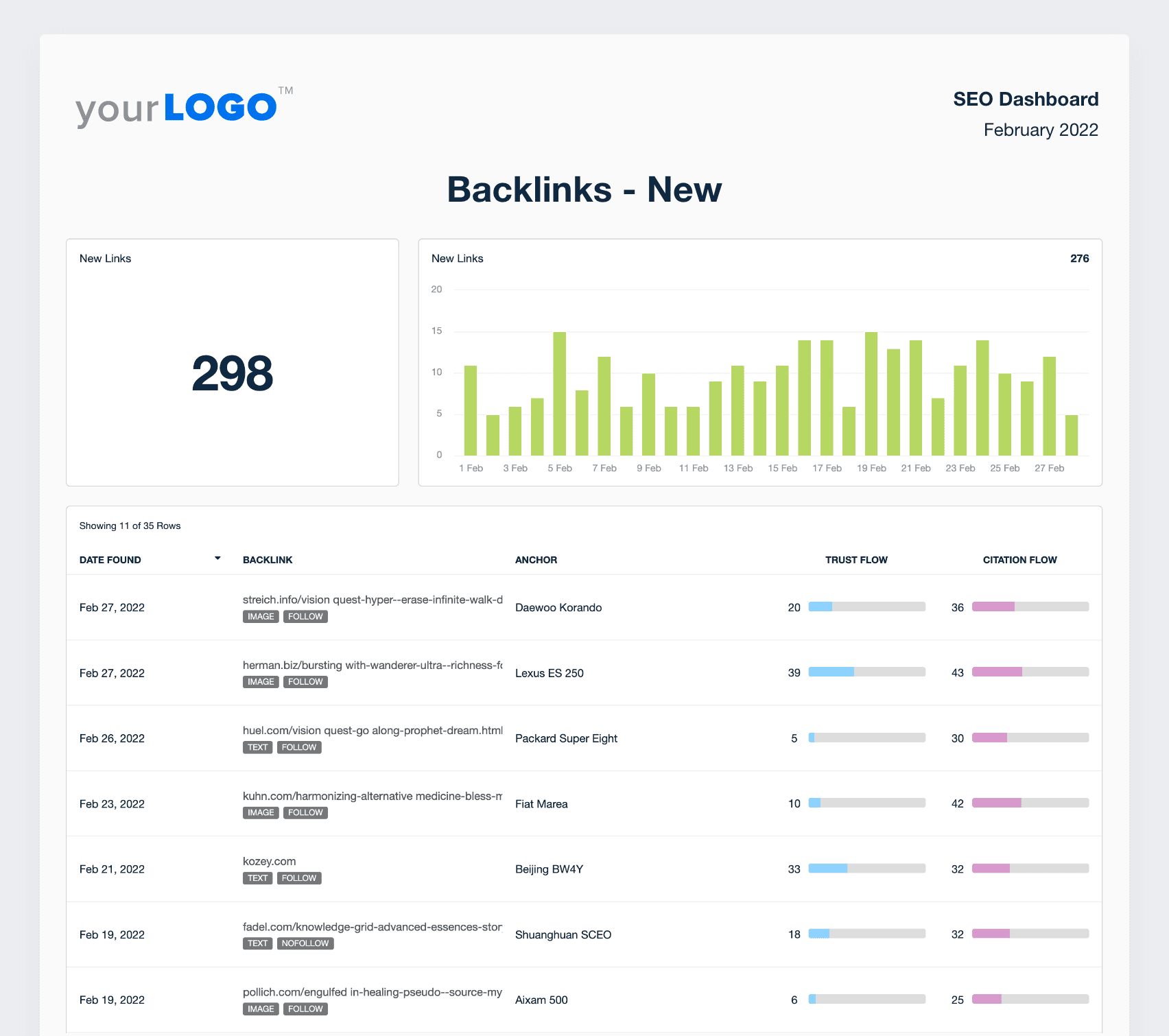
Present complete backlink data to clients with AgencyAnalytics’ white label SEO reports and dashboards. Start your 14-day free trial of AgencyAnalytics today!
Step 6: Study the Competition's Social Media Presence Using a Social Reporting Tool
Social media marketing also plays a huge role in search engine optimization. It’s often the best way to promote new content, reach your target audience, and drive web traffic.
After analyzing the competition and developing a plan for your client, it's also key to track their results with a social reporting tool to ensure the strategy is playing out as expected:
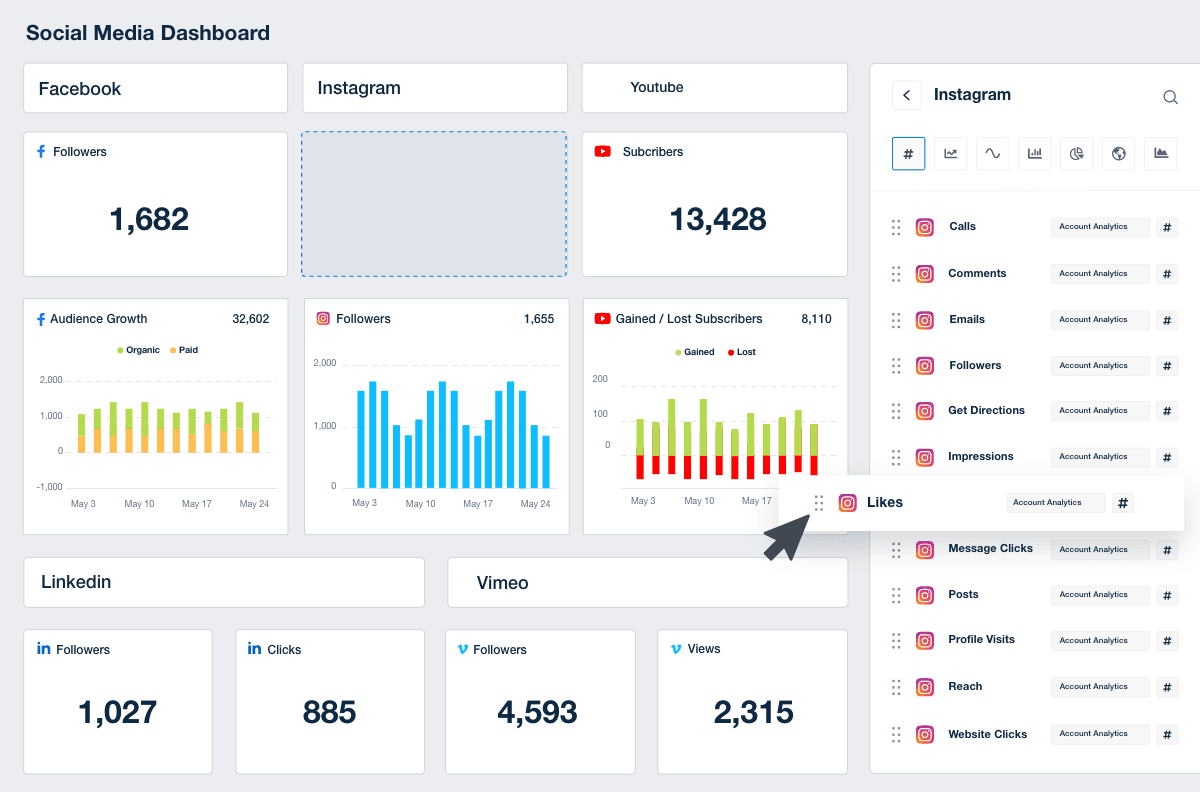
A social media dashboard makes it easy to track each platform's growth over time so that you and your clients see exactly where traffic and conversions are coming from, and which areas may need improvement.
After you've developed your client’s initial social media strategy, their competition is a great place to learn from and improve results. See which platforms they focus on, the posting frequency they use, and analyze how well each performs. Also, look at how they're using social media to represent their brand and, most importantly, how their followers respond.
While it's helpful to look to the competition for ideas and to learn from their mistakes, you'll ultimately need to create your own social media marketing strategy that fits your client’s own unique brand personality.
Free SEO Competitor Analysis Checklist
Enhance your clients’ SEO strategies with our Free SEO Competitor Analysis Checklist. Follow the steps to make sure you cover every detail and never miss a tactic!
Competitor Analysis: The Secret to Elevating Your SEO Strategy
Learning from your client’s competitors is one of the most effective ways to enhance their SEO strategies. By analyzing competitor tactics, you uncover valuable insights into what type of content resonates with your client’s audience, identify untapped opportunities, and refine your overall approach to drive results.
Remember that SEO is a constantly evolving field. To remain successful, make sure to keep your finger on the pulse of changes in search algorithms, emerging technologies, and shifting industry trends. Staying adaptable and proactive ensures that your strategies remain relevant and effective over time.
To streamline your efforts, use AgencyAnalytics to monitor and track all SEO activity in one centralized SEO dashboard. Keep your team and clients aligned, simplify reporting, and showcase the impact of your work—all in one platform. Start your 14-day free trial of AgencyAnalytics today!

Written by
Joe is the co-founder and CEO of AgencyAnalytics, a marketing reporting platform used by more than 7,000 agencies. With experience creating multiple businesses, he thrives on tackling the challenges of sustainable growth and innovation.
Read more posts by Joe KindnessSee how 7,000+ marketing agencies help clients win
Free 14-day trial. No credit card required.






